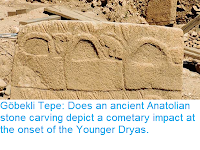Bread is one of the most widely consumed Human foodstuffs today, and is believed to have originated in the Middle East at about the same time as the first cultivation of cereal crops, and spread around the world with that technology. Bread is made by milling cereals (Grass seeds) to make a fine flour, then fermenting it prior to baking, to produce a versatile foodstuff that can be stored in an edible form for some months.
In a paper published in the Proceedings of the National Academy of Sciences of the United States of America on 10 July 2018, Amaia Arranz-Otaegui of the Department of Cross-Cultural and Regional Studies at the University of Copenhagen, Lara Gonzalez Carretero of the Institute of Archaeology at University College London, Monica Ramsey of the McDonald Institute for Archaeological Research at the University of Cambridge, Dorian Fuller, also of the Institute of Archaeology at University College London, and Tobias Richter, also of the Department of Cross-Cultural and Regional Studies at the University of Copenhagen, describe the discovery of bread fragments from a Late Pleistocene site in northern Jordan.
The discovery comes from an Epipalaeolithic (the term used to describe the period between the Palaeolithic in the Middle East - roughly equivalent to the Mesolithic of Western Europe) Natufian settlement in the Black Desert of northern Jordan, dated to about 14.6-11.6 thousand years ago, named Shubayqa 1. The Natufians were a civilisation found around the eastern Mediterranean, who are noteworthy for their adoption of a settled lifestyle several millenia before the advent of agriculture.
Arranz-Otaegui et al. discovered crumbs in two fireplaces that they identified as bread on the basis of gas cells within the structure, a sign that it has been baked, which is not seen in remnants of porridges or similar substances. Given the absence of any oven-like structure at the site, it is suggested that the bread was baked on a hot stone, or in the ashes of a fire.
Analyses of these crumbs revealed the presence of single-celled aleurone layers (aleurone is a protein found in seeds and other plant-energy stores such as tubers), which are indicative of grains such as Wheat (Triticum), Rye (Secale), Millets (Panicum and Setaria), and Oat (Avena), and possibly double- or triple layered aleurone found in grasses such as Barley (Hordeum). This fits with the other archaeobotanical remains found at the site, which includes fragments of Wild Einkorn Wheat (Triticum boeoticum/urartu), Barley (Hordeum spontaneum), and Oat (Avena sp.), as well as Club-rush tubers (Bolboschoenus glaucus), Crucifers/Brassicas (Cruciferae or Brassicaceae), and small-seeded Legumes (Trigonella/Astragalus).
As well as the grain material the bread was also found to contain other plant tissues, such as parenchyma cells, vascular tissue, and root-type starch, thought likely to have come from Club-rush tubers (Bolboschoenus glaucus), which were very abundant at the site.
The grains used in making the bread appear to have been ground very fine and/or sieved carefully, far more so than is typically found in breads made by later neolithic peoples, though this is not completely surprising, as the Natufians are known to have made extensive use of grinding and pounding tools, presumably for food preparation.
See also...
Arranz-Otaegui et al. discovered crumbs in two fireplaces that they identified as bread on the basis of gas cells within the structure, a sign that it has been baked, which is not seen in remnants of porridges or similar substances. Given the absence of any oven-like structure at the site, it is suggested that the bread was baked on a hot stone, or in the ashes of a fire.
Scanning electron microscope images of bread-like remains from Shubayqa 1. (A) Sample number 6 showing the typical porous matrix of bread with small closed voids. (B) Detail of an aleurone layer from sample number 17 (at least single celled). (C) Sample number 12 showing vascular tissue, the arrow marks the xylem vessels in longitudinal section. Arranz-Otaegui et al. (2018).
Analyses of these crumbs revealed the presence of single-celled aleurone layers (aleurone is a protein found in seeds and other plant-energy stores such as tubers), which are indicative of grains such as Wheat (Triticum), Rye (Secale), Millets (Panicum and Setaria), and Oat (Avena), and possibly double- or triple layered aleurone found in grasses such as Barley (Hordeum). This fits with the other archaeobotanical remains found at the site, which includes fragments of Wild Einkorn Wheat (Triticum boeoticum/urartu), Barley (Hordeum spontaneum), and Oat (Avena sp.), as well as Club-rush tubers (Bolboschoenus glaucus), Crucifers/Brassicas (Cruciferae or Brassicaceae), and small-seeded Legumes (Trigonella/Astragalus).
As well as the grain material the bread was also found to contain other plant tissues, such as parenchyma cells, vascular tissue, and root-type starch, thought likely to have come from Club-rush tubers (Bolboschoenus glaucus), which were very abundant at the site.
The site of Shubayqa 1 showing one of the fireplaces (the oldest one) where the bread-like remains were discovered. Arranz-Otaegui et al. (2018).
The grains used in making the bread appear to have been ground very fine and/or sieved carefully, far more so than is typically found in breads made by later neolithic peoples, though this is not completely surprising, as the Natufians are known to have made extensive use of grinding and pounding tools, presumably for food preparation.
See also...
Follow Sciency Thoughts on Facebook.







